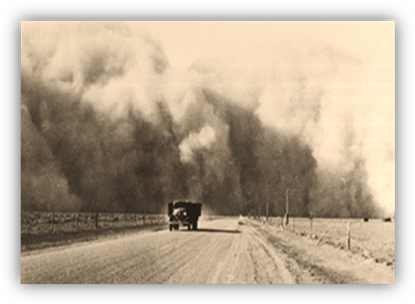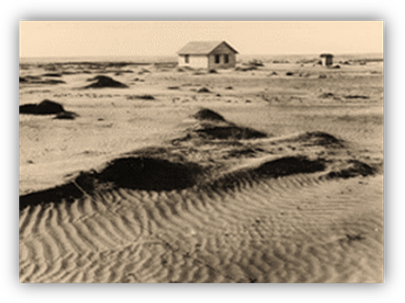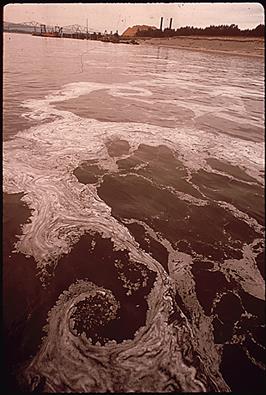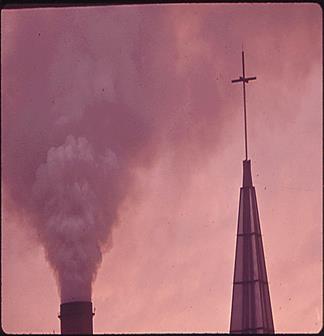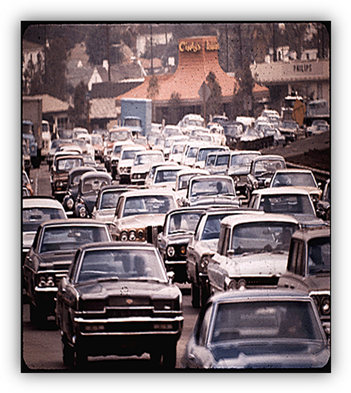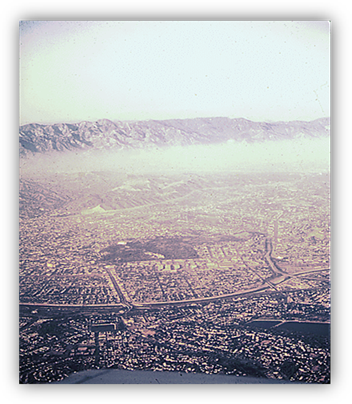![j0236211[1]](SCI170U21Save_Money_image002.gif)
SAVE THE ENVIRONMENT? SAVE MONEY?
Unit Overview
In the past, decisions on how to provide a service to
humankind were often based on what was fastest and least expensive to
accomplish. After years of neglecting the environmental consequences of our
actions, we now have to deal with pollution of our air, soil, and water. Toxins
in our food are now causing us to be concerned about how we are managing our
natural resources. Is using the most readily available energy sources the best
for our planet in the long run? How can we take care of our planet and still
provide for our needs and desires. How can we help the under developed nations
avoid some of our mistakes? These and other questions are dealt with as you
study this unit.
The Controversy![bd06482_[1]](SCI170U21Save_Money_image004.png)
A little over two hundred years ago when the United States was in its infancy, few people anywhere in the world worried about the environment. The global population was not nearly as large as now, and the Industrial Revolution was just beginning in Europe. Coal was being burned in large quantities, and, within several decades, would be used to make iron and steel, and also electricity. Coal produced dirty smoke and odors, but that was the price which was paid for a good source of heat and energy to power steam engines that ran many of the early factories. The Industrial Revolution emerged first in Great Britain. At the beginning of the 1800s, people began moving from the farms where wages were low, and machines were beginning to replace the hired hands. By 1851, half of the population of England lived in London. Houses built for the factory workers and their families were small and poorly constructed. There was no running water, and there were no toilets. Along the street there was one pump and two toilets for all the residents to use. There was no system to dispose of household waste, so it was thrown into the streets. Predictably, disease spread through the crowded urban areas. In 1832, 31,000 people in England died of cholera. Typhus, dysentery, and small pox also killed many.
Coal mines were also very dangerous places to work
with dust and cave-ins constantly threatening workers’ lives. The chilly, damp
atmosphere within the mines also led to respiratory illnesses. Children, often
forced to work in mines or factories, worked long hours and were often
mistreated. Many suffered injuries or death. In the cotton mills, hands could
be crushed or hair could get caught in the machines, scalping the victims or
killing them outright. In match factories, children were employed to dip
matches in phosphorus. Exposure to this element could rot their teeth or harm
their lungs.
Later in the nineteenth century, the United States
endured similar problems. In 1860 there were only nine cities in the U.S. with
populations over 100,000, but by 1900, there were 38 such cities. Children often
suffered ill effects from factory work here, as well. Eventually, both
countries enacted laws to protect workers from unsafe working conditions.
Children under a certain age were completely barred from work in factories. As
cities grew, forests were cut down to build houses and factories. This
destroyed habitat for plants and animals. More roads were built and, with the
invention of the steam engine, railroads became popular. Miles of railways were
constructed to bring raw materials to the factories and take products to
markets. Machines required an energy source, so coal mining increased, which
also affected habitat and the quality of land, air, and water.
In the mid 1800s the first oil well was drilled, but
it was not until the end of that century, when the automobile was introduced,
that the use of petroleum dramatically increased. Early in the 1900s, Henry
Ford’s inexpensive automobiles greatly increased the use of petroleum since
more people could afford cars. In addition to the increased mining of coal,
large numbers of oil wells were being drilled. In early drilling operations,
pressure under the ground would, at times, send the oil gushing into the air.
These “gushers” created pollution in the area where the oil landed.
On the positive side, some improvements in people’s
lives resulted. Many had more money to buy goods, and more products were now
available for sale. Health care was slowly improving, but there was now more
exposure to harmful chemicals than ever before, which could harm one’s health.
Where will all this lead? Can we produce new products
and labor-saving devices and still maintain our health and the environment of
our planet? Let’s examine some modern day problems and their possible
solutions.
Protection or Destruction
of Forests?
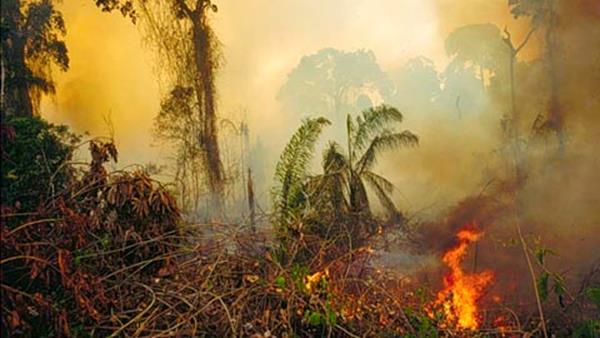
|
Deforestation by burning the rainforest increases global warming. |
Forests serve important ecological purposes by serving as a habitat for plants and animals. Soil is conserved by plant and tree roots holding it so it is not washed away. Roots also help to regulate water supply by absorbing rainfall instead of having it run off into streams and lakes or evaporate into the atmosphere creating more rainfall. The trees themselves and other forest plants provide lumber, ingredients for drugs and medicines, and attract tourists who like to hike, hunt, and fish in these areas. There are over 5000 products made from trees, including toothpaste and clothing. Forests in Central Africa are home to 8000 species of plants. In addition, the forests provide the setting for the process of photosynthesis, which consumes carbon dioxide and creates oxygen. For this reason, some call rainforests the “lungs of the earth.” More than one-fifth of the oxygen produced in the world comes from the Amazon rainforest. As the carbon dioxide is used, the amount in the atmosphere is lowered and the greenhouse effect, which produces global warming, is slowed.
However, an area the size of a football field of
rainforest is destroyed every second to supply timber and to create open land
for agriculture and ranching. Clear-cutting is an easy method of lumbering
since whole areas are stripped of trees rather than selectively cutting only
the mature trees. This results in erosion of topsoil into the rivers, thus
reducing the fertility of the soil. Increases in carbon dioxide and reduction
of oxygen in the atmosphere result. Biodiversity, the number of different kinds
of plants and animals, is reduced. Scientists estimate we are losing 137
species a day, and many of these organisms are not even known. They are
becoming extinct, so we will never know if they might produce substances to
fight disease or improve our society. Fifteen ton machines with eight-foot
cutting discs chop up trees into bits smaller than a matchbox to be made into
cardboard and chipboard.
Land Use Practices – Wise or Unwise?
Careful use of land is important to provide food and
resources for the world’s population. Only about two and a half percent of the
surface of the earth is available for crop production and only about six and
one-half percent is usable as pasture land. This means we must take proper care
of the farm land that is available to raise food for the entire planet. At
times, land is cleared that is not the best for raising crops. This is true in
the Amazon rainforest where the thin topsoil can quickly be eroded away after
the trees are removed. Similarly, some areas become very dry even though the
topsoil may be adequate. In the United States in the 1930s, the Dust Bowl was
an area in the southern Great Plains where, after several years of drought,
crops could not grow. When the wind blew, huge amounts of topsoil became
airborne and darkened the sky. Families left areas of Kansas, Arkansas,
Oklahoma, Texas, Nevada, and New Mexico to find work or land elsewhere, since
they were starving and had no money. This plight lengthened the effects of the
Great Depression in the United States. John Steinbeck’s
novel, The Grapes of Wrath, is a tale of families leaving the dust bowl
to find a livelihood in California.
|
|
|
|
Dust Bowl scene in the 1930s – windblown topsoil creates air pollution and the loss of rich soil. |
After the wind dies down, soil is piled in drifts |
The process which gradually destroys land by over
cultivation and overgrazing and depletes the soil, leading to wind and water
erosion, is known as desertification. If not corrected, the land can be
useless. This is a growing problem throughout the world. It usually occurs on
semi-arid land and is aided by drought. Over cultivation destroys the nutrients
in the soil, and overgrazing can destroy the vegetation. With the vegetation
gone, water and wind wash and blow the topsoil away, and, in a few seasons,
centuries of build-up of soil can be lost.
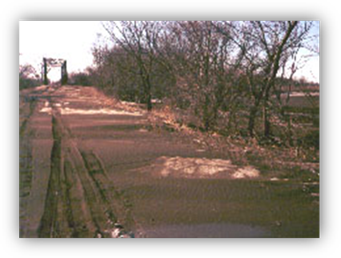
In the winter of 1995-96, South Dakota soil from fall
plowing blows into 2 to 3 feet drifts.(above left)
An area that has suffered devastating famine and
starvation in the early 1970s was sub-Saharan Africa. This is the region south
of the Sahara Desert and north of the moist savannahs or plains of Africa.
Depletion of the soil, caused by rapid population growth and six years of
drought, led to the death of 200,000 people and millions of cattle.
Deforestation, the removal of trees, and poorly controlled irrigation can also
lead to desertification. Over half of all dry lands in the world have suffered
some damage. Many of these are in North America.
Thirty percent of the U.S. lands west of the
Mississippi River and three of the provinces in Canada have experienced
desertification. Other areas in Asia, China, Latin America, and even Iceland
are facing problems. The loss of soil creates silting in rivers and air
pollution. In April of 2001, a yellowish cloud of soil from China was tracked
by satellite across the United States to the Atlantic Ocean.
When the soil is depleted, it leads to social unrest
and poverty, forcing people to move or starve. There are ways to combat this
process, but it requires action on the part of local groups and governments.
When some of the productive soil is removed from the agricultural resources,
people must be given other means of earning a living. Rotating crops and
terracing the soil into steps on sloped areas can help maintain the soil.
Rotating crops includes growing row crops one year and then a crop which holds
soil better, like hay or wheat, the next year. In 1992, the United Nations held
an “Earth Summit” to address the desertification throughout the world. One of
the outcomes was to encourage the developed nations to support the developing
nations in combating the land devastation problems. Local peoples and
governments must also get involved, especially women in the less-developed
countries who are in charge of the growing of crops for their families.
Educating them in ways to avoid soil destruction and/or providing jobs so they
no longer have to farm can help solve the problem. Secretary General Kofi Annan
of the United Nations stated on the World Day to Combat Desertification that
“fighting desertification must be an integral part of our wider efforts to
eradicate poverty and ensure long-term food security.” We must work towards
“achieving sustainable development for all, including the dry land rural areas
where the world’s poorest people live.” In the United States, individual states
are responsible for tackling the problem. But, as a nation, we must assume
responsibility to help those nations that are less wealthy than ours to combat
the problem within their borders.
Urbanization, the development of cities as people move
from rural areas to towns, creates problems. If growth is too rapid, problems
in providing sanitation, utilities, and proper housing result. Today, instead
of London, England, it is the cities of Africa, Asia, Latin America, and the
Caribbean that have these problems. In the slums of Nairobi, Kenya, there is
only one toilet for every 150 people. Waste water runs into the streets
creating water-borne disease problems. Carbon dioxide and nitrogen oxide
produced from factories and vehicles pollute the air causing respiratory
problems, such as bronchitis and asthma. Crime and poverty are often the end
results of rapid urbanization. The growth of cities also causes valuable
irreplaceable farmland to be used as sites for factories and homes. This lowers
the ability of the country to produce food for its people. Those people who
have moved to the city own no land and cannot produce food for them anymore.
As stated in earlier units, extracting our natural
resources from the soil can also harm the environment if not done wisely. In
the past when coal was removed by strip mining, the dirt and rocks that were
blasted away to reach the coal seam was simply left in piles and the high wall
or tall cliff that resulted was left after the coal seam was depleted. This
left the land permanently scarred and very dangerous. Little could be done with
the land which had been stripped of its topsoil and large depressions carved
out of it. These frequently filled with water and became strip pits that were
often overly acidic due to the presence of minerals deep in the soil that
dissolved into the water. This was also the cause of acid mine drainage from
shaft mines that had been dug deep into the earth and polluted local streams.
Fortunately, the Environmental Protection Agency now requires all operators of
stripped areas, including those who practice mountaintop removal, to return the
land to close to its original condition. This requires the saving of topsoil so
that it can be replaced back over the less fertile subsoil. Bulldozers must
move the dirt to fill in the depressions and remove the dangerous high walls.
Grasses are planted and cattle can graze in this area soon after the mining
operation stops. After a number of years the land can be used for other
purposes. Deep mines now must be sealed to prevent the seepage of mine acid
into local waterways. Even though these methods increase the cost of mining,
they are protecting our land and making it more valuable for future
generations.
Water, Water
Everywhere, But How Much Of It Can We Drink?
Our planet is unique in that so much of it is covered
by water, nearly three-fourths of the earth’s surface. Yet, only 2.5% is fresh
water and 87.5% of the fresh water is in the form of ice. Only .008% of the
water on our planet is available for human use. We cannot change the amount and
if we continue to pollute it, the amount will decrease. An increasing
population requires more, not less, water. Of the 6 billion people on earth
now, it is estimated that about 1.3 billion do not have access to clean water.
Water pollution from sewage leads to water-borne disease outbreaks. It is
estimated that seven children die per minute worldwide due to water pollution
and 25 million people per year die from water pollution.
Other causes of water pollution include the use of
fossil fuels which place sulfur and nitrogen oxide into the air as well as
mercury vapor. The oxides cause acid rain which can severely disrupt the health
of our lakes. Mercury can enter the food chain by contaminating water. Fish
ingest a form of mercury that dissolves in water and pass it on to other
animals that eat them. Improper application of fertilizers can cause eutrophication,
when waterways become over-fertilized from run-off from fields, and water
plants grow wildly, choking waterways and diminishing the oxygen in the water
available for fish. This happens because, as the plants die, their
decomposition removes oxygen from the water. Until it was banned, DDT, used as
a pesticide, was entering the water and causing detriment to fish and
particularly to birds of prey that ate them. This included osprey, eagles,
condors, and falcons.
|
Waste from a pulp mill pollutes the Columbia River in Washington State in September of 1972. (above left) |
Irrigation, which is the use of underground water to
water crops, can waste as much as 50 to 70% of the water by not directing it
properly or using too much or watering at the wrong time when most of it
evaporates instead of soaking into the soil. This depletes our sources of
underground water. Urbanization can add to this depletion problem by requiring
vast amounts of water from wells or from reservoirs. If rainfall diminishes,
water supplies are in trouble. Water is not only used for drinking and cooking,
but also to wash clothes and cars, to water lawns, for cooling processes in
industry and to serve as a solvent in industrial processes. In our country, Las
Vegas, Nevada, which lies in an arid part of our country, is one of the fastest
growing urban areas. Satellite data show less green than average on the earth’s
surface in Las Vegas, except where there are golf courses or cemeteries. This
urban area is taking more water from an already water-starved area of the
United States.
As discussed in earlier units, chemicals used in our
society often find their way into waterways and sometimes cause problems. Not
only do fertilizers from farmland over-fertilize water creating too much plant
growth, but pesticides, such as DDT, and industrial chemicals, like PCBs, can
enter the food chain through the fish and other organisms that live in our
waters.
This is the Air We Breathe
Air pollution, like water pollution, is also the
result of technological developments. Beginning with the Industrial Revolution,
which dramatically increased the use of fossil fuels, vast amounts of carbon
dioxide, methane, mercury, and nitrogen oxides have been released into the air.
This causes an increase in the average temperature of the earth. Without
greenhouse gases, the earth’s temperature would plummet from an average of 15
degrees Celsius (59 degrees Fahrenheit) to -18 degrees Celsius (-.4 degrees
Fahrenheit). This would severely limit the amount of food that we could grow.
However, the last 100 years has seen an increase in carbon dioxide of more than
25%.
It is predicted that in the next 50 years temperatures
will increase an average of 3 to 5 degrees and melt more of the polar ice caps.
This could cause ocean levels to increase by as much as 14 feet.
|
May 1073, Kaiser aluminum plant belching fumes over a residential area in New Orleans, Louisiana. (above left) |
Other more natural ways to combat global warming are
to reforest areas and use the ocean. Forests can absorb huge amounts of carbon
dioxide in a relatively short period of time by photosynthesis. However, when
trees are burned during forest fires or to clear forests and when plants
decompose, the carbon dioxide is released. Oceans, on the other hand, can absorb
as much as one-half of the carbon dioxide produced by fossil fuels. Coral reefs
use a large amount to produce their skeletons which are composed of carbonates.
Phytoplankton in the top 50 meters of ocean water use carbon dioxide through
photosynthesis. When ocean plants die and sink to the bottom, they release
carbon dioxide as they decompose but this can dissolve in ocean water,
especially in colder areas, and be held in solution for as long as a thousand
years. Research is being done on the possibility of pumping carbon dioxide into
the ocean to dissolve it. Adding nutrients to the ocean to increase the growth
of phytoplankton is also being studied.
Ozone is another gas in the atmosphere that affects
the health of our planet. The pungent smell after a thunderstorm is the result
of the production of ozone. In larger concentrations, it can irritate lungs and
eyes. Ozone is also created by automobile exhausts and can lead to respiratory
problems in the young, the elderly, and others suffering from respiratory
diseases. This is especially noticeable in areas like Los Angeles that have a
high population density and an abundance of cars. When smoke and fog along with
other contaminants mix, the condition is known as smog, a form of air
pollution.
|
|
|
|
Above: Hollywood-freeway in Los Angeles, California, May 1972 Right: Smog evident over Los Angeles, California, May 1972 |
|
However, the ozone layer in our stratosphere (35 to 58
miles high) protects against the ultraviolet rays from outer space, mainly from
the sun. These rays when can cause skin cancers and cataracts. Over a period of
years, it appears that this ozone layer is becoming thinner, especially over
Antarctica. As a result we have seen an increase in skin cancer and cataracts.
People are being warned to limit exposure to sunlight and to use sunscreen as a
preventive. In the 1980s the United States banned the use of CFCs
(chlorofluorocarbons) which are chemicals used as refrigerants, solvents,
cleaning fluids, propellants in aerosol cans, and foaming agents in the
production of foam plastics such as Styrofoam. Other chemicals have had to be
found to replace them. Some of these are more expensive and/or less efficient
but more environmentally friendly. To be environmentally friendly, a
product must cause little harm to the environment during its production. By
1996, many other nations agreed to limit production of these chemicals. Why?
They are thought to destroy the ozone in the stratosphere. It is hoped that the
ozone layer will now begin to be restored.
What Is Being Done?
On a national level, the United States established the
Environmental Protection Agency (EPA) to protect the national public health and
the environment in December of 1970. Its purpose was to find ways to clean up
and prevent pollution, to see that environmental laws are followed, to help the
states develop new air quality standards, to use scientific research to educate
the nation about environmental issues, and to set national health-based
standards for air pollution and for auto emissions. Some of the activities of
the EPA are:
·
the limiting of
exposure to lead, especially children, including the phasing out of lead in
gasoline
·
placing limits on
industrial water pollution
·
requiring cars to
have catalytic converters to reduce emissions
·
phasing out PCBs,
DDT, and CFCs – harmful
·
chemicals to the
environment and human health
·
creating a
Superfund to finance the cleanup
·
of toxic waste
dumps from industry
·
encouraging
efforts to stop the depletion of ozone worldwide
·
requiring
industry to keep records of the location, quantity, use, and disposal of toxic
material and make these records available to the public
·
fining industries
who pollute the environment (example: fining Exxon over 950 million to clean up
the Exxon Valdez oil spill)
·
requiring the
U.S. government to use recycled products and to recycle
·
alerting the
public to the dangers of second-hand smoke
These efforts are making the United States a safer
place to live and are protecting our nation’s resources.
|
A young osprey on its nest in the Chesapeake Bay region after the DDT ban. DDT caused shell-thinning in birds of prey that fed on fish. Often eggs never hatched. |
The National Aeronautics and Space Administration
(NASA) have launched several satellites that monitor environments around the
globe. The newest is the TERRA earth-observing satellite. It was launched in
December of 1999 and began sending data in March of 2000. It has 5 different
monitoring devices. One monitors the amount of moisture in the soil and can
sense minerals and land surfaces as small as 50 feet across. Another attempts
to understand Earth as a balanced energy system by measuring the warming and
cooling caused by clouds, how much sunlight is reflected by water, the
atmosphere, and land, and how much energy is absorbed and then emitted as heat.
A third takes 3-dimensional pictures of clouds and monitors nine different
aerosols. Aerosols are airborne particles. TERRA, for example, can
identify dust from a desert, smoke from a forest fire, pollution from a
factory, and volcanic ash. About 10% of aerosols are from human sources. They
can cool the planet by blocking sunlight or changing cloud formation. The
fourth device can detect 36 different wavelengths of light to determine ocean
temperature, the movement of phytoplankton in the ocean, and whether plants on
land have been destroyed or replenished. The fifth device tracks the production
and paths of methane and carbon monoxide. These are products of fossil fuel
burning, livestock, landfills, forest fires, and rice farming.
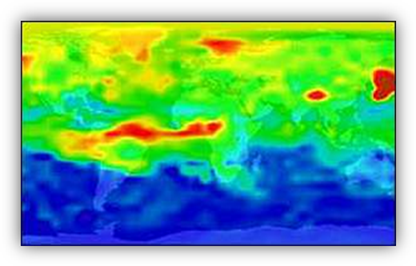
|
Above: The red spots indicate carbon monoxide, CO. Sources of this are: air pollution from US forest fires in summer, emissions from the burning of fossil fuels in the Northern Hemisphere during winter, and from forest and grassland fires in Africa and South America during the dry season. |
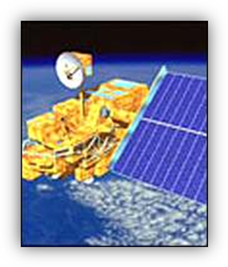 The United States Geological Survey has the world’s
largest data base of earth science information. It is known as EROS (Earth
Resources Observation System). Earlier NASA satellites, called Landsat, were
also remote sensing satellites that could detect earth surface changes such as
deforestation or crop disease. Many of them have since been sold to private
companies. Other satellites can detect ozone levels or provide weather
information.
The United States Geological Survey has the world’s
largest data base of earth science information. It is known as EROS (Earth
Resources Observation System). Earlier NASA satellites, called Landsat, were
also remote sensing satellites that could detect earth surface changes such as
deforestation or crop disease. Many of them have since been sold to private
companies. Other satellites can detect ozone levels or provide weather
information.
Another method of protecting the global environment is
through trade agreements with other nations. The World Trade Organization (WTO)
regulates international trade law and some feel that it will lower
environmental standards since American companies can produce products more
cheaply if they do not have to meet environmental standards. This would make
them more competitive worldwide. In addition, the General Agreement on Tariffs
and Trade (GATT) does not allow a country to refuse to accept a product based
upon whether environmentally friendly methods were used in its production.
People opposed to this said that US companies would try to get environmental
standards lowered or move their plants to countries where environmental
standards were lower. However, this turned out not to be the case at least in
one instance.
In 1991 the Tuna-Dolphin Dispute broke out between
Mexico and the United States. U.S. fishermen were limited to how many dolphins
could be killed in the nets that were set to catch tuna whereas Mexico had no
such limitation. The U.S. protested but it was not upheld. In response U.S.
tuna canners labeled their tuna as “dolphin safe” meaning that they did not
kill excessive amounts of dolphins. U.S. consumers who wanted the dolphins
protected would only buy cans labeled “dolphin safe”. The next year the United
States and nine other countries including Mexico signed an agreement that set a
limit on the amount of dolphins that could be killed while fishing for tuna.
Worldwide dolphin deaths decreased from 100,000 in 1989 to 3600 in 1993. Public
concern had made the difference.
About this time, the North American Free Trade
Agreement or NAFTA was signed. This was a green free trade agreement,
meaning it made environmental concerns part of the agreement. The U.S. or any
country could deny entry of any product from another country that did not meet
national standards. Individual states could even enact tougher restrictions
than the federal government if they so desired. Therefore, if a country
manufactured an item using methods that polluted the environment, a country
could refuse to import it based on that fact.
This brings us to a question: How do we measure the well-being of a country? Until recently this was done by using a number called the Gross Domestic Product (GDP) which was the market value (selling totals) of all the goods and services produced in a country in a given year. An increase in the GDP is either a reflection of population growth or the consumption of more goods per person. It is also an indication that more resources, both materials and energy sources, are being consumed. If we look at the following graph, we will see that, in the U.S., the GDP has steadily increased. Does this mean the U.S. is increasing the quality of life for its citizens? Perhaps not, because it does not include the effects of using these natural resources or the health effects from this production. It also underestimates the positive effects on society of using energy efficient methods which may not be the cheapest way to produce goods. Nor does it take note of foods individuals produce themselves or of volunteer work they may do. Nor does it indicate if the production of these products changes the spread of income and harmful effects over the population as a whole. That is, do some parts of the society benefit from this production while others are made poorer in money or in health than the others?
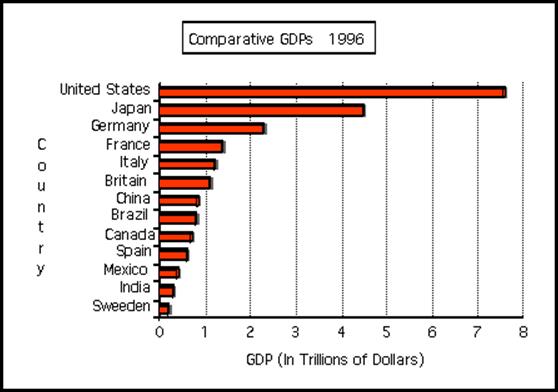
|
The graph at the above left shows the production of goods in the United States in 1996 was far greater than many other countries. But does this have anything to do with the quality of our lives, our health, and our environment? |
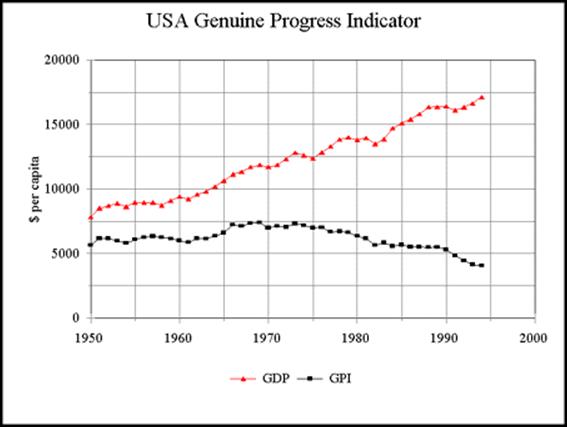
|
This graph charts the Gross Domestic Product for the United States from 1950 to 1994 in red. As you can see, it steadily raises showing that the value of our products per person has steadily increased. The Genuine Progress Indicator shown in black takes into effect the negative aspects of production – the pollution created, the use of resources, the negative health and economic effects on the citizens. Since 1969 this has shown a decrease. Does this mean we need to pay more attention to the negative effects of production? |
Is our quality of life really improving?
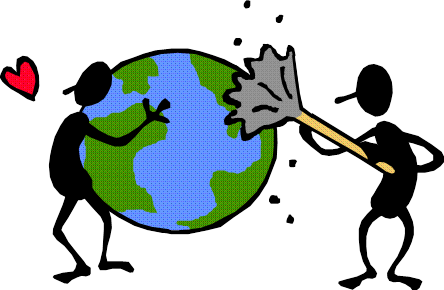
Unit Conclusions
When the Industrial Revolution began, many people thought that everyone’s standard of living would improve. Wages were higher and more products were available to make our lives easier. But the costs of this production in the areas of use of resources and health were not being measured. As pollution of water, air, and land increased due to the use of fossil fuels and the shift and growth in population, some parts of the population were made to live in poor housing and work in unsafe conditions, causing their health to suffer. Poor agricultural practices led to desertification in many areas with people starving or forced to move elsewhere. After a couple of hundred years the negative effects of industrialization and population growth are taking their toll. Americans and others around the globe are awakening to the fact that the planet must be protected from pollution of air, water, and soil. Methods that protect the environment must be used even if they make a product or crop cost more. The public must be educated to recycle, reuse, and reduce the amount of materials they use. Governments must agree to set limits on the amount they add to global warming and must use their knowledge and resources to help other less developed countries avoid some of the mistakes those developed nations have made. If we are to lower poverty and starvation, we must take good care of our water, land, and atmosphere. Even in America, it is time to wake up and improve.
